13+ Script Writing Examples
Behind every movie that you have seen and every theater play that you have attended, there is a pad of paper that refers to the detailed outline of the story being portrayed. This group of sheets is what we call “script.” Though watching your favorite comedy show entertains you, most of them have scriptwriting that is no joke. In this article, we are going to discuss the basic principles and nature of writing a script. Read through and be the scriptwriter of the next phenomenal movie.
A script (also known as a screenplay) creates a outline of the whole story to be acted out by actors for a film, a stage play, a television program example, etc. Aside from the dialogue, also narrates the actions, expressions, and movements of the characters (i.e. actors). If you haven’t seen a script before, this is now your chance. Here are some examples to let you have a glimpse of what they look like.
Scriptwriters, often called screenwriters, play a crucial role in the storytelling process for visual media. They are responsible for crafting the plot, developing characters, writing dialogue, and describing the settings and actions within a screenplay. A well-written script serves as the foundation for the entire production and helps translate the writer’s creative vision into a format that can be easily understood and executed by the cast and crew.
In screenwriting, there are specific formatting guidelines and industry standards that writers must follow to ensure clarity and consistency. Screenplays are typically divided into scenes, with each scene described in detail to convey the visual and auditory elements required for the production. Proper formatting and organization are essential for a script to be professional and practical for production.
Scriptwriting is a collaborative process, and screenwriters often work closely with directors, producers, and other creative professionals to refine and develop their scripts. The goal of scriptwriting is to create a compelling and engaging story that can be brought to life on screen, stage, or in other visual media.
What is Script Writing?

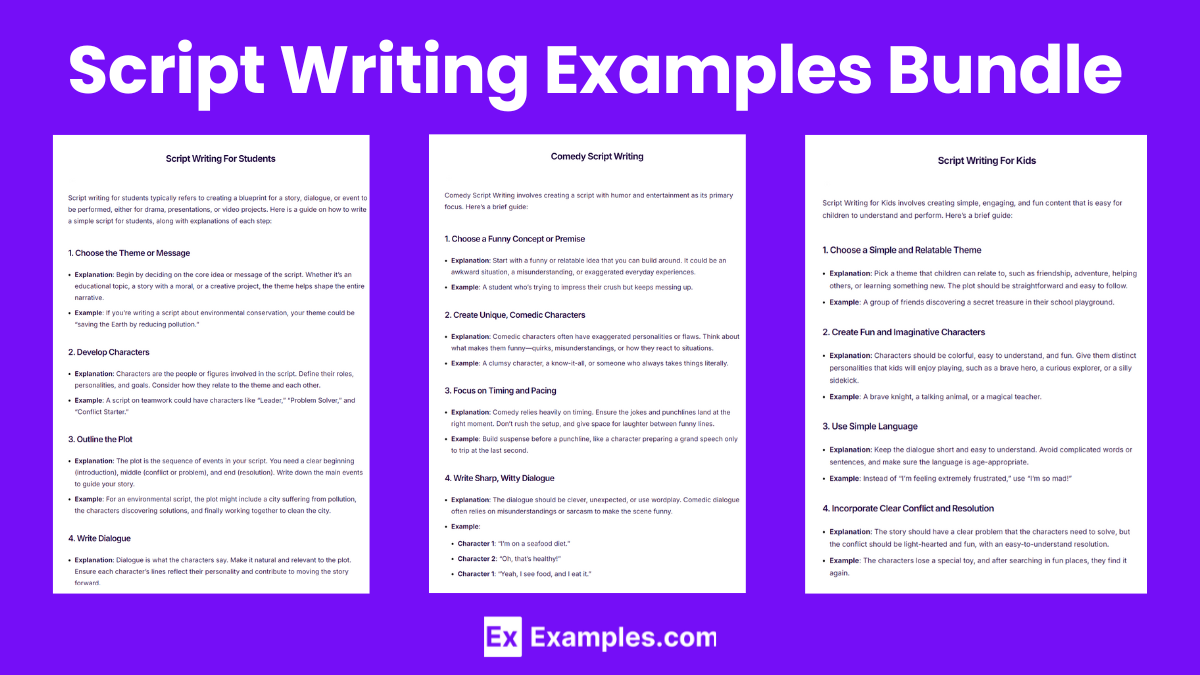
Download Script Writing Bundle
Script Writing Format
Title Page
Title of the script: Centered and in capital letters.
Written by: Beneath the title, also centered.
Writer’s contact information: At the bottom left corner (optional).
Scene Heading (Slugline)
- INT. or EXT. indicating whether the scene is interior or exterior.
- Location: A brief description of the setting.
- Time of Day: Usually DAY or NIGHT.
Action (Description)
- Describes the setting, characters, and what is happening in the scene.
- Written in the present tense and only includes what can be seen or heard.
Character Name
- When a character is introduced for the first time, their name should be in all caps.
- Above their dialogue, centered on the page.
Dialogue
- Underneath the character’s name, the dialogue is centered and enclosed in quotation marks.
- Keep dialogue lines concise for readability.
Parenthetical
- Directions for actors (how they should say their lines) are placed in parentheses, just below the character’s name and before the dialogue.
- Use sparingly.
Transitions
- Terms like CUT TO:, FADE IN:, FADE OUT., etc., are used to indicate changes between scenes.
- Typically aligned to the right of the page.
Extensions
Used next to character names to indicate off-screen (O.S.) or voice-over (V.O.) dialogue.
Formatting Specifications:
- Font: 12-pt, Courier font is standard.
- Margins: Left margin 1.5 inches, right margin 1 inch (approx.), top and bottom margins 1 inch.
- Spacing: Dialogue is typically single-spaced, while action and scene descriptions are double-spaced.
Software:
Many screenwriters use specialized software like Final Draft, Celtx, or WriterDuet, which automatically formats the script according to industry standards.
Short Script Writing Example
Title: “Casablanca” – Opening Scene
Scene: INT. RICK’S CAFÉ AMÉRICAIN – NIGHT
The setting is Rick’s Café Américain, a bustling nightclub in the city of Casablanca during World War II. The atmosphere is smoky and filled with an eclectic mix of people, including refugees, expatriates, and shady characters. The hum of conversation and music creates a lively backdrop.
Characters:
- RICK BLAINE, the enigmatic and sophisticated owner of the café, impeccably dressed.
- CARL, the affable and observant bartender.
- VICTOR LASZLO, a heroic resistance leader, and his companion ILSA LUND, an elegant woman with an air of mystery.
Action:
- The camera pans across the café, highlighting the diverse patrons and their interactions. A jazz band plays in the background.
- Rick stands behind the bar, calmly observing the crowd, a half-smoked cigarette in his hand.
- Suddenly, Victor and Ilsa enter the café, drawing everyone’s attention. Victor is stoic, while Ilsa is both beautiful and anxious.
- Rick watches them closely, his demeanor unchanging.
- The band strikes up “La Marseillaise,” and the patrons join in, singing the French national anthem in a show of unity and resistance against the German occupiers.
- Rick’s eyes remain fixed on Victor and Ilsa, revealing a depth of emotion beneath his cool exterior.
Script Writing For Students

Comedy Script Writing

Script Writing For Kids
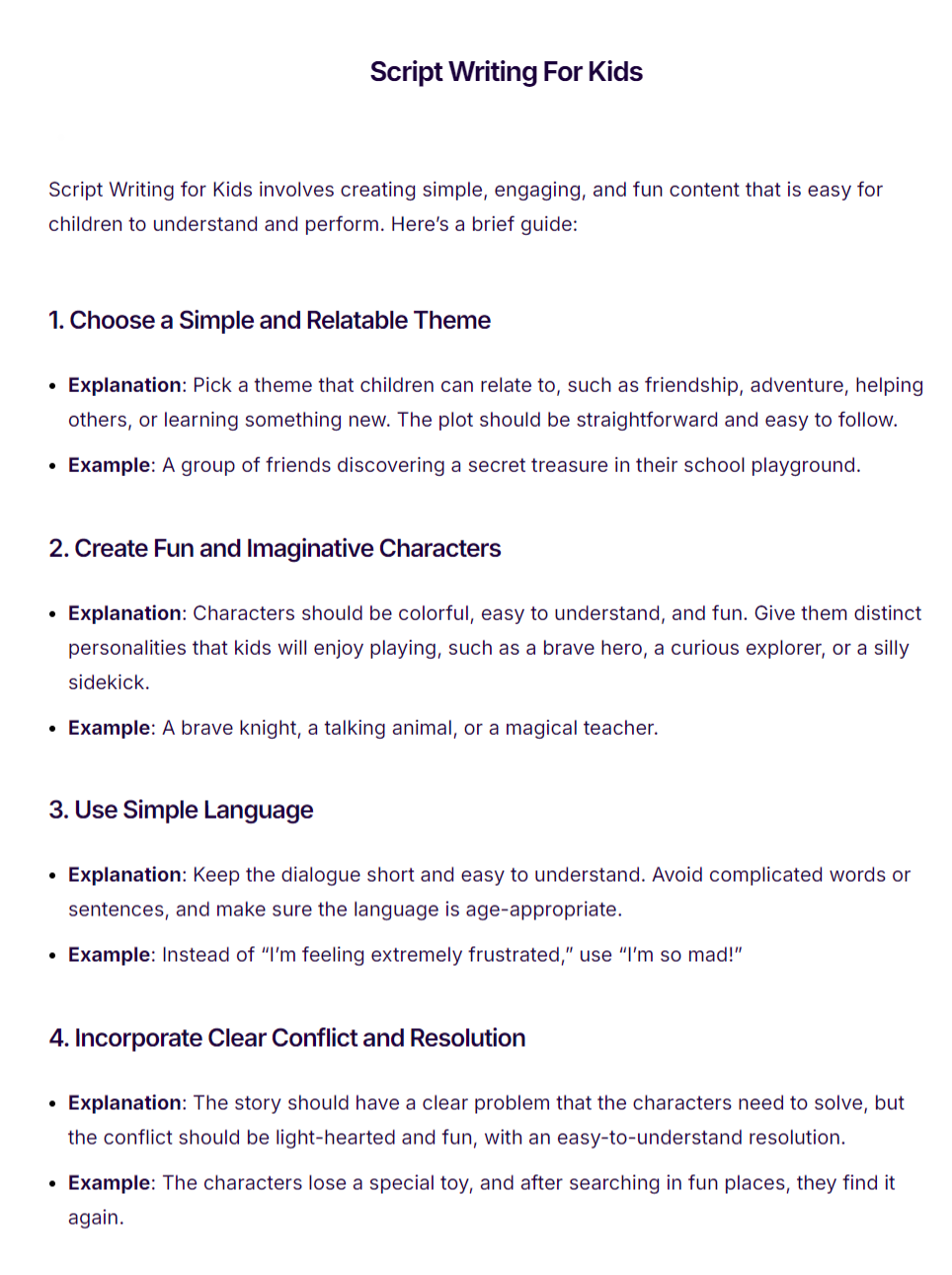
More Script Writing Examples & Samples
Script Writing Examples & Samples
1. Short Script Writing Examples
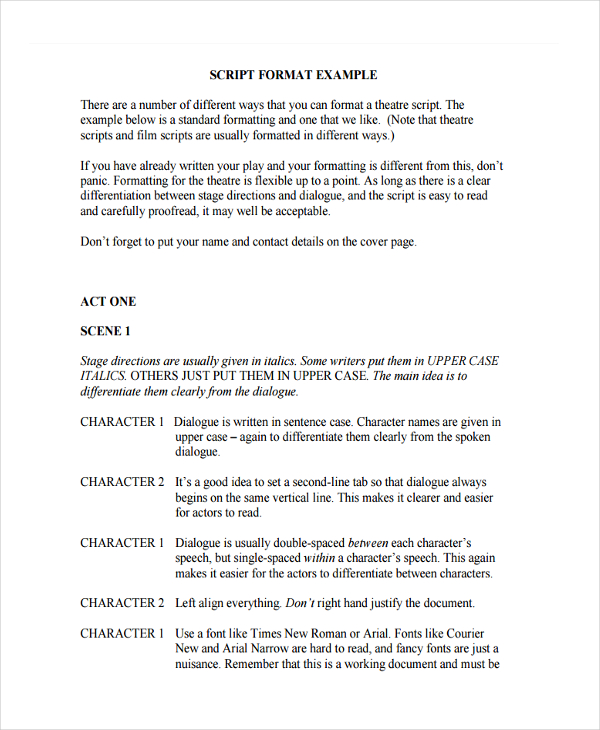
2. Cartoon Script Writing Examples

3. Movie Script Writing Examples
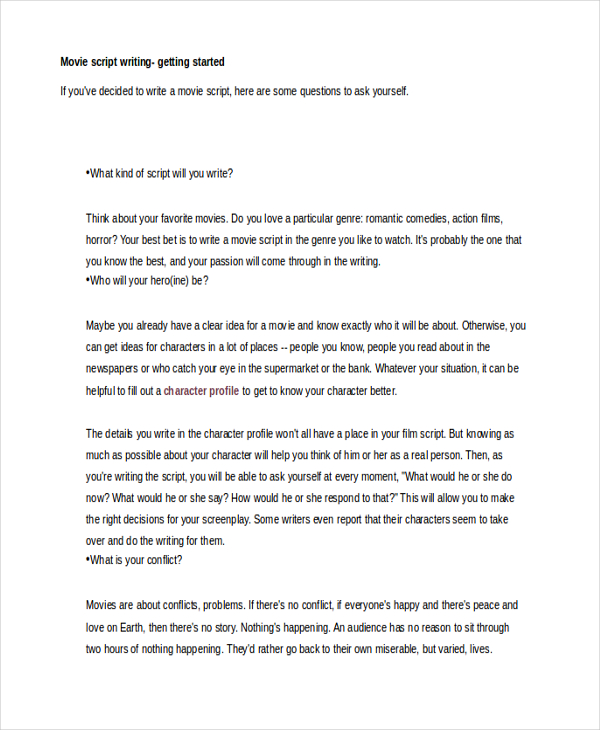
4. Documentary Script Writing Example
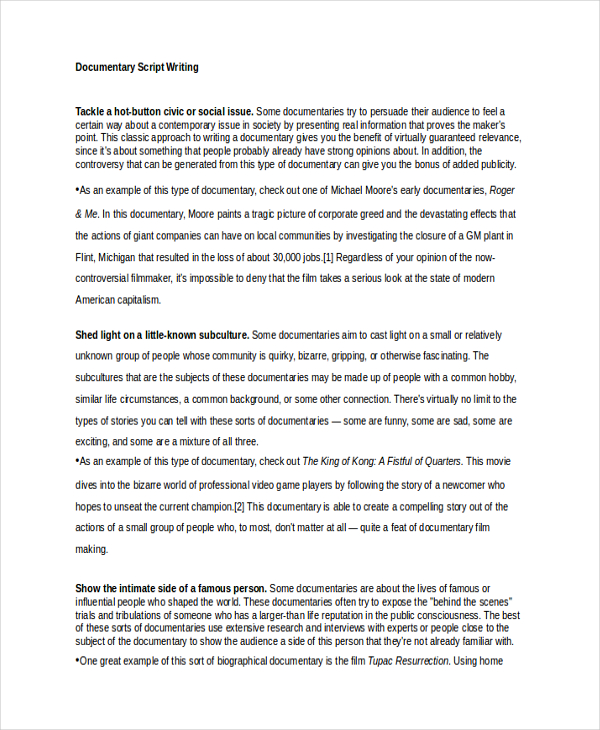
5. Social Script Writing Example
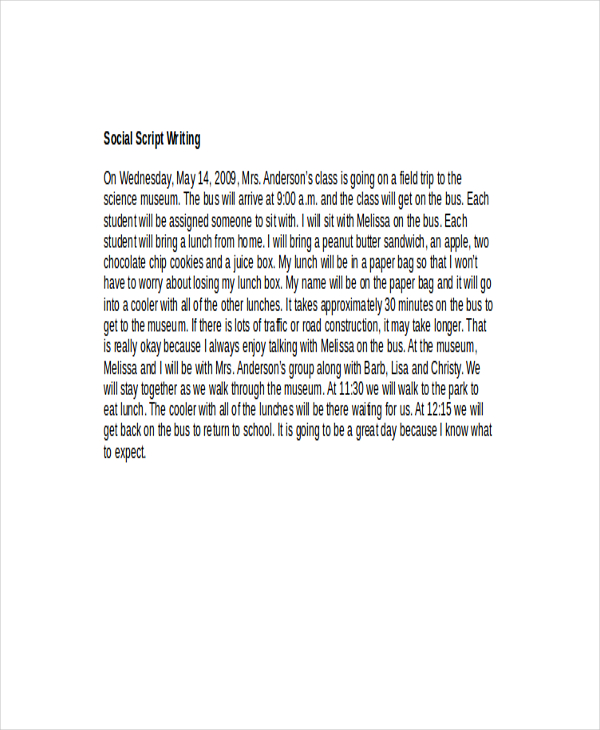
6. Story Script Writing Example
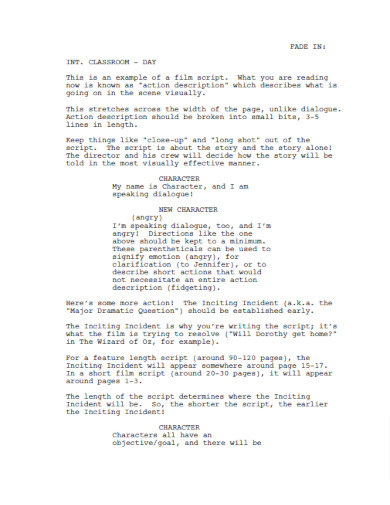
7. Sample Candidate Script Writing

How to Write a Script Writing?
Writing a script involves several key steps, regardless of whether it’s for a film, television, theater, or radio. Here’s a concise guide on how to write a script effectively:
Develop Your Idea
Start with a clear concept. What is the story about? Identify the genre (comedy, drama, horror, etc.) and the central theme or message you want to convey.
Create an Outline
Structure your script with a detailed outline that includes:
Beginning: Set up the story, introduce characters, and establish the setting.
Middle: Present the main conflict or challenge the characters face.
End: Resolve the conflict and provide closure.Build Characters
Develop compelling characters with distinct personalities, motivations, and arcs. Consider how they will evolve throughout the story.
Write Dialogue
Craft natural-sounding dialogue that reflects each character’s voice. Avoid exposition-heavy conversations; show character relationships and emotions through their words.
Use Proper Formatting
Follow industry-standard formatting for your script:
Title Page: Include the title, your name, and contact information.
Scene Headings: Indicate the location and time of day (e.g., INT. KITCHEN – DAY).
Action Lines: Describe what is happening in the scene.
Dialogue: Center character names above their lines.
Parentheticals: Use sparingly to indicate how a line should be delivered (e.g., (sarcastically)).Incorporate Visuals and Sound
For film or TV scripts, think visually. Describe actions and settings that enhance the storytelling. For radio scripts, include sound cues to create atmosphere.
Revise and Edit
After completing the first draft, review your script for clarity, pacing, and engagement. Seek feedback from others and make necessary revisions.
Read Aloud
Read your script aloud or have others perform it to see how it flows. This helps identify awkward dialogue or pacing issues.
What is difference between script and screenplay?
| Aspect | Script | Screenplay |
|---|---|---|
| Medium | More general and can refer to any written document intended for performance, including scripts for theater, radio, and more. | Specifically refers to a written document for a film or television production. |
| Audience | May be intended for actors, directors, or theater production teams, depending on the context. | Primarily intended for filmmakers, including directors, producers, actors, and crew members involved in film or TV production. |
| Format | Formatting and style may vary depending on the medium (theater, radio, etc.). | Follows industry-standard formatting guidelines specific to the film or TV industry. |
| Description | Generally used for a broader range of performances and may include more narrative description and stage directions. | Focuses more on visual and audio elements relevant to film or television, such as camera directions and scene transitions. |
| Detail | May contain more detailed descriptions of the characters and their actions to guide actors and directors. | Typically contains less character and action description, as this is often left to the director’s interpretation. |
| Usage in Film/TV | Less common in the context of film and TV, as “screenplay” is the preferred term for these mediums. | The standard term used for writing for film and television. |
| Example | A stage play script, a radio script, or a script for a live theater performance. | A script for a feature film, a TV series episode, or a teleplay for a TV show. |
Tips for Script Writing
- Understand your audience: Tailor your content and tone to engage the specific audience you are targeting.
- Start with a strong premise: A compelling premise is essential for capturing interest. Define what makes your story unique.
- Focus on character development: Create multi-dimensional characters with clear goals, motivations, and arcs that drive the narrative.
- Write visually: Describe settings and actions vividly to help the audience visualize the story rather than relying solely on dialogue.
- Keep dialogue natural: Write authentic dialogue that reflects each character’s voice and avoid overly formal language unless it suits the character.
- Show, don’t tell: Use actions, expressions, and subtext to convey emotions and information without relying heavily on exposition.
- Structure your script: Follow a clear structure, typically consisting of a beginning, middle, and end. Use an outline to organize your thoughts.
- Revise and edit: Be prepared to revise multiple times. Edit for clarity, pacing, and engagement, cutting unnecessary scenes or dialogue.
- Read scripts by others: Familiarize yourself with scripts from various genres to analyze what works and learn from established writers.
- Get feedback: Share your script with trusted peers or mentors to gather constructive feedback that helps identify strengths and weaknesses.
- Practice regularly: Write consistently to improve your skills and experiment with different genres, styles, and formats.
FAQS
1. How do I start script writing?
To start script writing, begin by developing a strong premise or idea. Create an outline, build your characters, and then write your first draft, focusing on dialogue and visual storytelling.
2. What format should I use for script writing?
Script writing typically follows a specific format, which includes scene headings, action lines, character names, and dialogue. You can use screenwriting software like Final Draft or Celtx to help with formatting.
3. How important is character development in script writing?
Character development is crucial in script writing. Well-developed characters with clear motivations and arcs help engage the audience and drive the story forward.
4. What are some common mistakes to avoid in script writing?
Common mistakes in script writing include overwriting dialogue, neglecting character development, failing to structure the script properly, and not revising the draft thoroughly.
5. Should I include stage directions in my script writing?
Yes, including stage directions can be helpful, especially in theater scripts. However, in film and TV scripts, it’s important to focus more on visual storytelling and actions.
6. Is collaboration common in script writing?
Yes, collaboration is common in script writing, especially in film and television. Working with other writers, directors, and producers can enhance the script and bring different perspectives.


